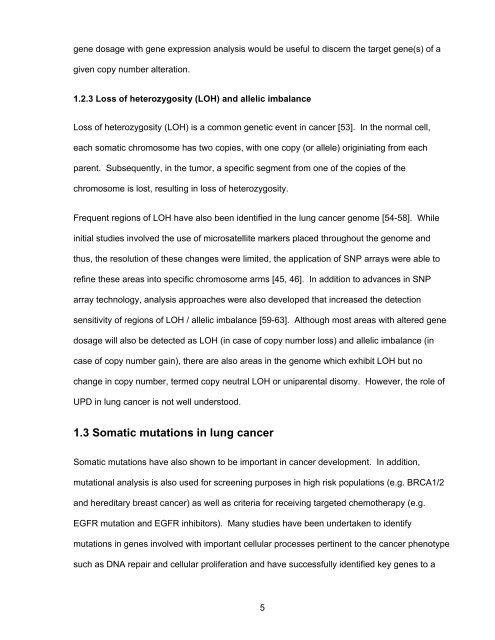Chapter 2 - University of British Columbia
Chapter 2 - University of British Columbia
Chapter 2 - University of British Columbia
You also want an ePaper? Increase the reach of your titles
YUMPU automatically turns print PDFs into web optimized ePapers that Google loves.
gene dosage with gene expression analysis would be useful to discern the target gene(s) <strong>of</strong> a<br />
given copy number alteration.<br />
1.2.3 Loss <strong>of</strong> heterozygosity (LOH) and allelic imbalance<br />
Loss <strong>of</strong> heterozygosity (LOH) is a common genetic event in cancer [53]. In the normal cell,<br />
each somatic chromosome has two copies, with one copy (or allele) originiating from each<br />
parent. Subsequently, in the tumor, a specific segment from one <strong>of</strong> the copies <strong>of</strong> the<br />
chromosome is lost, resulting in loss <strong>of</strong> heterozygosity.<br />
Frequent regions <strong>of</strong> LOH have also been identified in the lung cancer genome [54-58]. While<br />
initial studies involved the use <strong>of</strong> microsatellite markers placed throughout the genome and<br />
thus, the resolution <strong>of</strong> these changes were limited, the application <strong>of</strong> SNP arrays were able to<br />
refine these areas into specific chromosome arms [45, 46]. In addition to advances in SNP<br />
array technology, analysis approaches were also developed that increased the detection<br />
sensitivity <strong>of</strong> regions <strong>of</strong> LOH / allelic imbalance [59-63]. Although most areas with altered gene<br />
dosage will also be detected as LOH (in case <strong>of</strong> copy number loss) and allelic imbalance (in<br />
case <strong>of</strong> copy number gain), there are also areas in the genome which exhibit LOH but no<br />
change in copy number, termed copy neutral LOH or uniparental disomy. However, the role <strong>of</strong><br />
UPD in lung cancer is not well understood.<br />
1.3 Somatic mutations in lung cancer<br />
Somatic mutations have also shown to be important in cancer development. In addition,<br />
mutational analysis is also used for screening purposes in high risk populations (e.g. BRCA1/2<br />
and hereditary breast cancer) as well as criteria for receiving targeted chemotherapy (e.g.<br />
EGFR mutation and EGFR inhibitors). Many studies have been undertaken to identify<br />
mutations in genes involved with important cellular processes pertinent to the cancer phenotype<br />
such as DNA repair and cellular proliferation and have successfully identified key genes to a<br />
5

















